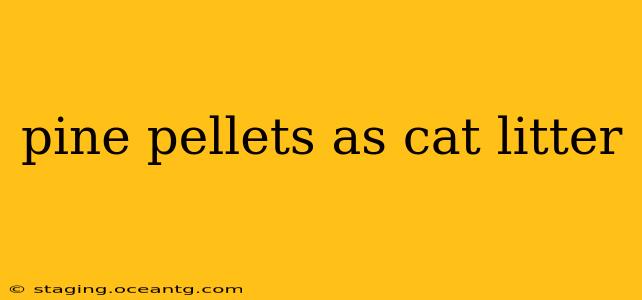Using pine pellets as cat litter is gaining popularity, but is it the right choice for your feline friend and your home? This comprehensive guide delves into the advantages and disadvantages of using pine pellets as cat litter, helping you make an informed decision. We'll explore common concerns and offer alternatives to ensure your cat's comfort and your home's cleanliness.
What are Pine Pellets?
Pine pellets are compressed sawdust, primarily made from pine wood. They're commonly used for heating and grilling, but their absorbent properties also make them a viable option for cat litter. Unlike clay litter, pine pellets are naturally biodegradable and often marketed as eco-friendly. However, it's crucial to understand the nuances before making the switch.
Benefits of Using Pine Pellets as Cat Litter
- Excellent Odor Control: Pine pellets effectively absorb liquids and neutralize odors through the natural properties of the pine wood. The scent itself can mask unpleasant smells, providing a fresher-smelling litter box.
- Cost-Effective: Compared to some clumping cat litters, pine pellets can be more economical in the long run, especially if purchased in bulk.
- Biodegradable and Eco-Friendly: Pine pellets are a renewable resource and are biodegradable, reducing environmental impact compared to clay-based litters. However, always ensure they're disposed of properly, as improper disposal can still have negative environmental consequences.
- Dust-Free (Generally): Many users find pine pellet litter to be less dusty than clay litter, which can benefit cats with respiratory sensitivities. However, ensure the pellets are completely dust-free before introducing them to your cat.
Drawbacks of Using Pine Pellets as Cat Litter
- Not for All Cats: Some cats are simply not comfortable using pine pellet litter. The texture can be different from what they're used to, leading to refusal to use the litter box.
- Potential for Digestive Issues: The essential oils in pine can be irritating to a cat's digestive system if ingested, and some cats may show an increased interest in consuming the pellets. This risk is exacerbated if your cat tends to eat their litter.
- Not Clumping: Pine pellets absorb urine and break down, but they don't clump like clay litter. This means scooping and cleaning the litter box is more like completely replacing the contents more frequently.
- Potential for Splinters: While rare, there's a small risk of splinters from the pellets, especially if they're not fully compressed.
Are Pine Pellets Safe for Cats?
This is a frequently asked question, and the answer is generally yes, if used correctly and the cat does not ingest the pellets. The main concern is the ingestion of the pellets and the essential oils in the pine. Look for dust-free, 100% pine pellet litters, and monitor your cat's behavior and stool quality. If you notice any digestive issues, switch to a different litter immediately.
How Often Should You Change Pine Pellet Litter?
Because pine pellets don't clump, they need to be changed more frequently than clumping litter. The frequency depends on the number of cats and the size of the litter box but generally requires a full replacement every 1-2 weeks, or even more often with multiple cats. Regularly scoop solid waste daily to maintain a clean and hygienic environment.
What are the Alternatives to Pine Pellets?
Several alternative cat litters are available, each with pros and cons:
- Clay Litter: This is a traditional option, readily available, and often inexpensive. However, it's not biodegradable and can be dusty.
- Silica Gel Litter: Highly absorbent and excellent for odor control, but can be expensive.
- Paper Litter: Biodegradable and generally low-dust, but may not be as effective at odor control as other options.
- Wheat Litter: Biodegradable, less dusty than clay, and suitable for many cats.
Can Pine Pellets Cause Allergies in Cats?
While pine pellet litter is often considered less dusty than clay, it's not completely allergy-free. Some cats might be sensitive to the pine scent or the wood particles themselves. Monitor your cat for any signs of sneezing, itching, or respiratory issues.
Ultimately, the best cat litter depends on your individual cat's preferences and your specific needs. Consider your cat's sensitivities, your budget, and your environmental concerns when making your decision. Always supervise your cat's use of any new litter and consult your veterinarian if you notice any unusual behavior or health issues.
